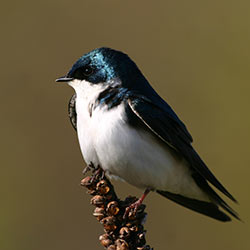
Tree Swallow
Posted by Grange Co-op on 28th Feb 2016
Male: Upperparts iridescent blue; underparts bright white; dark on head encloses eye. In late summer and fall, iridescent upperparts may appear greenish. They have a small bill and folded pointed wings which do not project beyond a short, forked tail.”
Female: Similar to male, only duller.
Immature: Gray brown with a white belly and grayish breast band.
 NESTING:
NESTING:
Loosely colonial, Tree Swallows nest in a natural cavity, old woodpecker hole or nest box. Nest is made of weeds, grass, rootlets and other plant material lined with fine grass, feathers and sometimes pine needles. Fed by the male, the female incubates 4-7 white eggs for 14-15 days; young fledge at 18-22 days. One brood per year.
RECOMMENDED NEST BOX:
Any Bluebird-style nest box with a 1.5” or 1 9/16” entrance hole, placed 5-10ft. above the ground on a pole. Shop Birdhouses.
FEEDING:
Hawks for flying insects, especially mosquitoes, low over land or water. Requires insects in spring breeding season, but unlike other swallows, can subsist for extended periods on seeds and berries before fall migration. Shop Wild Bird Food.
HABITAT:
Open areas, usually near woods and water, including urban lawns.
OTHER INTERESTING FACTS:
The Tree Swallow is the first swallow species to return each spring. It is attracted to your yard with a nest box, most common along ponds, lakes and agricultural fields. It competes with Western and Mountain Bluebirds for cavities and nest boxes. It travels great distances to find dropped feathers to line the nest. Sometimes seen chasing after dropped feathers and other swallows carrying feathers in their mouths. The Tree Swallow is the only North American passerine with an immature-plumaged female in the 1st and 2nd year. This immature plumage allows them to approach breeding adults and their nests without being chased away. This, in turn, lets them monitor breeding pairs and be ready to replace any adult female that dies during the nesting season. Gathers in large flocks to migrate in fall to Mexico and Central America.
COMPARE TO:
The Violet-green Swallow male has a green back, “cap” and nape, plus purplish wings, rump (white sides) and tail. White on face extends above eyes and wing.
Would you like to attract birds to your yard? We’ve got a great selection of products to help you and your feathered friends get together. Shop our Wild Bird department now.
